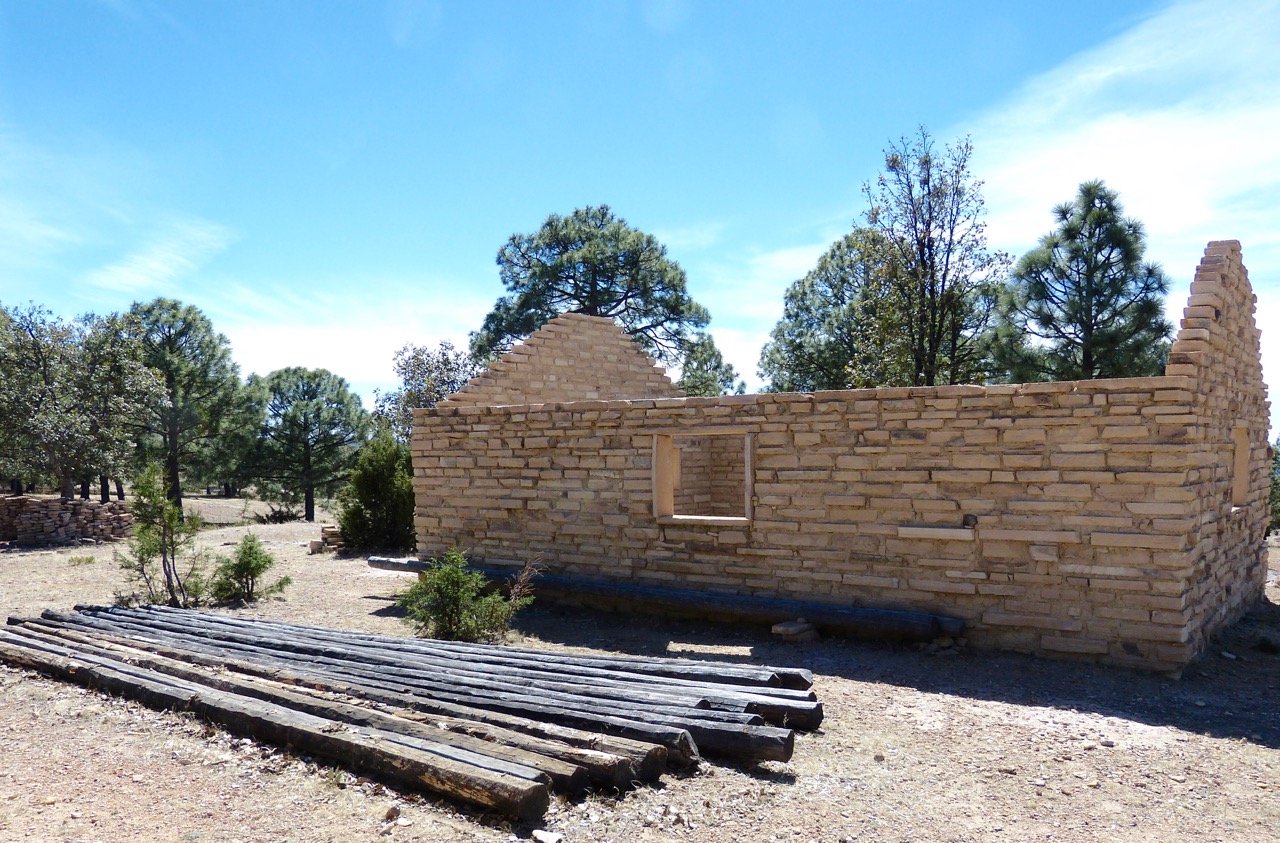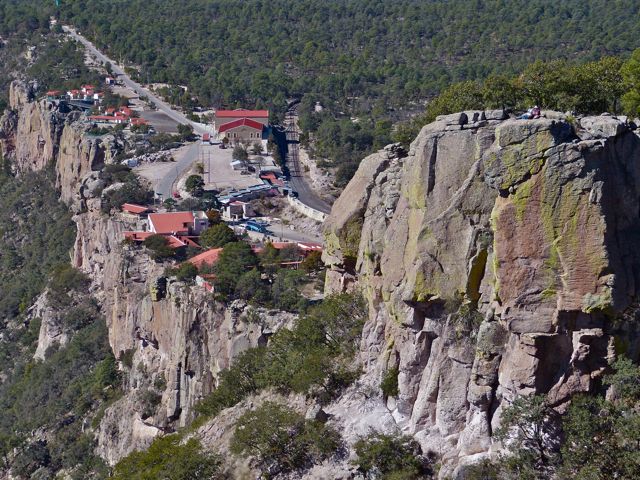

 |
 |
Currently, our main project is to put a roof on an unfinished building in Mesa Mogotavo. Copper Canyon should also be a contender for the Dark Sky Initiative whose poster child is the vast Gila Wilderness, or a UNESCO World Heritage Site designation or Geo-Park since Paquime was obviously a major stop on the several pereginations across the Bering landbridge from North to South America, but we certainly don't have the resources for that. However, if you doubt the authenticity of Paquime, look at the influence, authenticity, and reputation of the pottery from Mata Ortiz. Or the half dozen little-known cliff ruins that rival Betatakin in Arizona, or Mesa Verde in Colorado. In Mexico, that culture is known as the "Conjunto Mogollon". Look it up. But I degress.
The beautiful roofless stone building of local stone at the village of Mogotavo is only a 30 minute walk from the nearby ChePe train station at Estacion Divisadero. It is a fun walk, although sometimes a bit breathtaiking at over 7000 feet. It is a peaceful location. Imagine a few benches with cool clear water; for touists, locals, and horses. But first, we need to pay the local men to fell, strip, and cut to length the vigas for the roof. With enough interest and incentive, we hope that we can get the men to make the cedar shingles for the roof. Readily available galvanized panels have made splitting shingles a disappearing art. Additional donations will be invested in an off-grid photovoltaic array. Most Tarahumara in the region, no matter how remotely they live have a basic State-sponsored PV system that consists of a single panel on a simple ground mount, a 12V battery with a charge controller, and 2 CFL bulbs with 2 light switches. Curiously, Mogotavo, so close to the train station doesn't have solar. Could it be that by making infrastructure less available, the inhabitants will leave, and the government can build another hotel on this prime real estate? The main purpose of this building would be for local crafts, specifically as a location for the backstrap looming of blankets and rugs.
Tourism is the biggest engine of legal commerce in the Sierras. Industrial and State tourism instead of being a welcome investment threaten to dispossess, dislocate, and disenfranchise the locals from the land where the indigenous have generations of investment. Visitors to Divisadero are overwhelmed by the melee as they step off the train. Hundreds of indigenous Tarahumara and serranos are hawking food, crafts, and tours. Just past the gauntlet of vendors is the first breathtaking view of the canyon. The steep drop-off from the edge is a welcome relief to get it all in perspective, but from this perspective the view is no less inspiring. The Hotel Divisadero Barrancas overhangs the canyon. Floor to ceiling windows allow patrons the chance to sip a Margarita and blithely comment on a breathtaking but harsh, unforgiving terrain literally at their fingertips. Outside the window, life and labor goes on in the thin air of the mile-and-a-half high mesas. Laborers plow fields for crops, fell trees for houses, herd goats for fertilizer, and harvest meager crops produced by dry farming, while hotel patrons slip off to the the restroom to flush precious water in the comfort of "public toilets". Meantime, the locals tear a newspaper into shreds or carry cornhusks for toilet paper in handmade latrines, and get weekly deliveries of water to the communal cistern at the nearby church. At Mogotabo! That's our next project. Water harvesting gutters and cisterns at the church and community center.
Our Trek
 |
Another project, and we're looking for volunteers for this one. The route of Lumholtz’ well documented trek has for the most part faded into obscurity. Our trek, our retracing of that route, through the Sierras of Sonora and Chihuahua is multifold. We hope to raise awareness of the indigenous culture of the region. Not just Indian culture, but Serrano independence play a big role in this area that is farthest from the influence of the capital in Mexico City. We hope to highlight various people we meet who endeavor to make a living. Currently, the main sources of employment are mining, lumber and contraband; but there are trout farms, and furniture makers, and cheese production in the most secluded places, and a fledging but growing tourism industry. This region is a wonderful location for multiday adventures including horse backriding, mountain biking, kayaking, hiking, and birding, and 4wd. There are also secluded ranches and peaceful rivers for those seeking solitude. Whether you're looking to meditate, increase corporate team building skills or finish a book, the sierras are tranquil. Many of the locals are still aware of the botanical uses of their plants, a skill rapidly disappearing or being replaced by untested patented concoctions. This innate knowledge is disappearing fast in all but the most remote areas. We're aware of the violence in the region, but spending a lot of time there already, we're more aware of the disproportionate reporting of that violence, and of the detrimental effect it has on the inhabitants.
 |
Our Support
Whenever we can, we support the locals. We’re trying to help them help themselves to put a roof on a community center in Mogotabo. The forces allied against this effort are strong. Their Mesa overlooks the train station at Divisadero. What a great place for another hotel. It’s a no brainer for development. That has to be the reason that of so many communities who have government help, this community gets no help for solar, or clean water, or women’s health. This amounts to child neglect by the government. It has to be deliberate. In the past 5 years, the government and industrial tourism have installed an Austrian cablecar, the ZipRider- a 2.4 km double seated Tyrollean traverse, and an outdoor ampitheater on the canyon rim at the Parque Adventura Tarahumara. They’ll certainly get to that building before we do. If not, cnce there is a roof, the women can use the space for a weaving co-operative to make and sell rugs and blankets. The men can use the space as a headquarters for a sherpa co-operative, or as a woodshop for crafts with some community owned tools like a drill press and table saw. We have stock piled solar panels and some tools to donate, but the roof project takes more involvment. Maybe you want to get involved!
Your Support
You can become involved in our ambitious plans by making a donation. As far as the hike is concerned, we hope to GPS our route and have various opportunities to blog our progress so our sponsors can stay engaged in our effort. We also would like to hire locals as guides or packers. Their unique perspective would naturally highlight our trip with some aspect of the region that they probably take for granted. Naturally, we're also eager to be able to pack our gear on horseback for various legs of the journey, but we won't know about those people until we meet them.
As far as the roof is concerned, we need the men to cut, peel, and haul vigas. Then they could make cedar shingles, but they should get paid the prevailing wage for all this work. Only then can the solar panels, and lighting be installed. Currently the timeline just stretches on.
Please Contact Us by eMail or call 520-589-8034, to direct your donations. We also accept Zelle, bank transfers, and checks. Thank you for your consideration.
 |
Make checks or money orders payable to Copper Canyon Trails, LLC, and send to:
1334 West Pennington Street --- www.coppercanyontrails.org --- Tucson, AZ 85745 --- Phone: 520-589-8034Please include a project to which we can direct your donation. Contact Us: